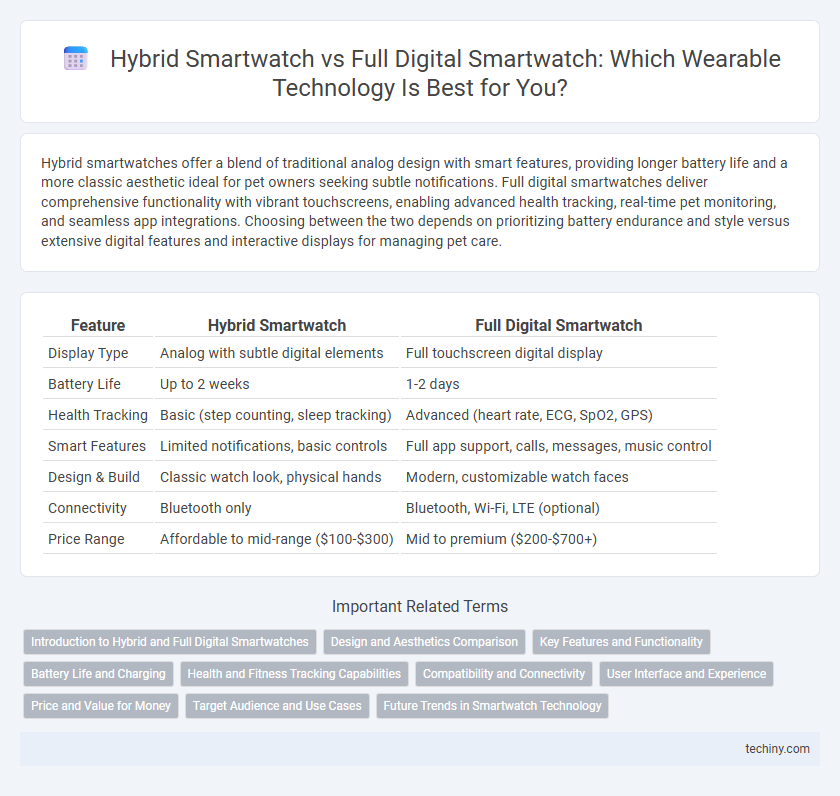Hybrid smartwatches offer a blend of traditional analog design with smart features, providing longer battery life and a more classic aesthetic ideal for pet owners seeking subtle notifications. Full digital smartwatches deliver comprehensive functionality with vibrant touchscreens, enabling advanced health tracking, real-time pet monitoring, and seamless app integrations. Choosing between the two depends on prioritizing battery endurance and style versus extensive digital features and interactive displays for managing pet care.
Table of Comparison
| Feature | Hybrid Smartwatch | Full Digital Smartwatch |
|---|---|---|
| Display Type | Analog with subtle digital elements | Full touchscreen digital display |
| Battery Life | Up to 2 weeks | 1-2 days |
| Health Tracking | Basic (step counting, sleep tracking) | Advanced (heart rate, ECG, SpO2, GPS) |
| Smart Features | Limited notifications, basic controls | Full app support, calls, messages, music control |
| Design & Build | Classic watch look, physical hands | Modern, customizable watch faces |
| Connectivity | Bluetooth only | Bluetooth, Wi-Fi, LTE (optional) |
| Price Range | Affordable to mid-range ($100-$300) | Mid to premium ($200-$700+) |
Introduction to Hybrid and Full Digital Smartwatches
Hybrid smartwatches combine traditional analog watch design with limited digital features such as fitness tracking and notifications, offering longer battery life and a classic aesthetic. Full digital smartwatches provide a touchscreen interface and extensive functionalities including GPS, heart rate monitoring, app integration, and customizable watch faces. Choosing between hybrid and full digital smartwatches depends on user preference for style, battery longevity, and technological capabilities.
Design and Aesthetics Comparison
Hybrid smartwatches combine traditional analog watch faces with digital features, offering a classic, timeless design appealing to users who prefer subtle technology integration. Full digital smartwatches feature vibrant, customizable touchscreen displays, emphasizing modern aesthetics and extensive visual functionality. The choice between hybrid and full digital smartwatches often hinges on user preference for elegant analog styling versus dynamic, interactive screen design.
Key Features and Functionality
Hybrid smartwatches combine traditional analog watch design with limited smart features such as activity tracking, notifications, and longer battery life, appealing to users who value classic aesthetics alongside basic connectivity. Full digital smartwatches offer comprehensive touchscreen interfaces, advanced health monitoring including ECG and SpO2 sensors, GPS navigation, app integrations, and customizable watch faces, prioritizing functionality and interactive user experience. Battery longevity is generally superior in hybrid smartwatches due to simpler components, whereas digital models require frequent charging but deliver richer, versatile smart features.
Battery Life and Charging
Hybrid smartwatches offer significantly longer battery life, often lasting several weeks on a single charge due to their combination of analog components and limited digital functionality. Full digital smartwatches typically require daily or bi-daily charging because of their high-resolution touchscreens and constant connectivity features. Advances in fast charging technology are reducing downtime for full digital models, though hybrid smartwatches remain superior for users prioritizing extended battery endurance.
Health and Fitness Tracking Capabilities
Hybrid smartwatches combine traditional analog design with essential health metrics such as heart rate monitoring and sleep tracking, offering extended battery life and subtle notifications. Full digital smartwatches provide comprehensive fitness features, including GPS tracking, advanced workout modes, real-time biometric data, and integration with health apps for detailed analysis. Users seeking robust health and fitness insights benefit more from full digital smartwatches, while those preferring simplicity and longer battery performance may opt for hybrid models.
Compatibility and Connectivity
Hybrid smartwatches offer broad compatibility with both Android and iOS devices, integrating traditional analog watch features with basic digital notifications through Bluetooth connectivity. Full digital smartwatches provide advanced connectivity options such as Wi-Fi, LTE, and NFC, enabling seamless app integration and real-time data synchronization across multiple platforms. While hybrid models prioritize longer battery life with simplified paired functions, full digital smartwatches excel in interactive compatibility for fitness tracking, messaging, and mobile payments.
User Interface and Experience
Hybrid smartwatches combine traditional analog displays with subtle digital notifications, offering a minimalist user interface that extends battery life and reduces screen glare. Full digital smartwatches provide a fully interactive touchscreen experience with customizable widgets, apps, and notifications, delivering a richer and more versatile user experience. Users seeking simplicity and longer battery performance may prefer hybrid models, while those prioritizing extensive functionality and interactive features lean towards full digital smartwatches.
Price and Value for Money
Hybrid smartwatches typically offer a more affordable price point compared to full digital smartwatches while still delivering essential features like fitness tracking and long battery life. Full digital smartwatches, although pricier, provide advanced functionalities such as high-resolution touchscreens, extensive app ecosystems, and enhanced connectivity options. Consumers seeking the best value for money should consider hybrid models for budget-friendly durability and basic smart features, whereas full digital smartwatches offer greater versatility worth the higher investment.
Target Audience and Use Cases
Hybrid smartwatches appeal to professionals seeking a stylish accessory with basic fitness tracking and extended battery life, ideal for seamless integration into formal settings and daily activities. Full digital smartwatches target tech-savvy users demanding comprehensive health monitoring, app connectivity, and personalized notifications for active lifestyles and multitasking environments. Fitness enthusiasts benefit more from full digital models with GPS and workout analytics, while casual users prioritize hybrid devices for simplicity and classic design.
Future Trends in Smartwatch Technology
Hybrid smartwatches blend traditional analog design with digital functionalities, offering longer battery life and classic aesthetics appealing to style-conscious users. Full digital smartwatches provide comprehensive health tracking, app integration, and customizable interfaces, driving innovation through advancements in AI and sensor technology. Future trends indicate increased focus on seamless health monitoring, augmented reality features, and enhanced connectivity with IoT devices, shaping smarter, more versatile wearables.
Hybrid Smartwatch vs Full Digital Smartwatch Infographic

 techiny.com
techiny.com